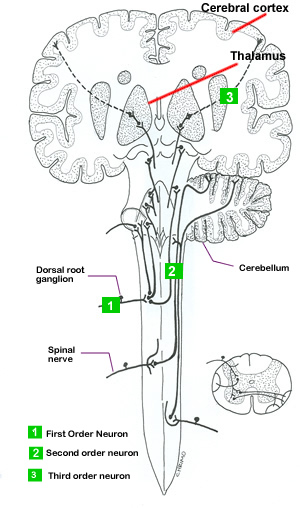| PATHWAYS FOR SIMPLE
(LIGHT) TOUCH AND PRESSURE |
|
| Spinal Sensations |
|
 |
- Receptors include Merkel's
discs, peri-trichial plexuses,Krauss and Ruffini end-bulbs , Meissner's
and Pacinian corpuscles
- Dendrites of first order neurons travel in spinal nerves and cell bodies are found in dorsal root ganglia.
- Axons from ganglia pass through the dorsolateral tract and bifurcate on entering the dorsal
white column of the spinal cord.
- The ascending and descending branches give
off collaterals to the gray mater.
- Both ascending and descending fibres synapse with tract neurons in Laminae 1,5,6 and 7.
- Second order tract neurons decussate, and ascend in the ventral spinothalamic tract. Some fibres remain ipsilateral.
- This tract synapses in nucleus ventralis posterior of the thalamus.
- Third order neurons traverse internal capsule, corona radiata to the somatosensory cortex.
|
Note: Traditionally,
in humans, it has been customary to recognize a lateral
spinothalamic tract containing fibres conveying
pain and temperature information, and a more medial
ventral spinothalamic tract containing fibres
conveying innocuous tactile information. However, this division has
no basis in experimental observation and the two are currently just
referred to as the spinothalamic tract. |
|
Cranial Sensations
- Primary order neurons travel in the Trigeminal , Facial, glossopharyngeal and vagus nerve
- Cell bodies are found in the corresponding ganglia
- The central processes bifurcate, one process enters the spinal tract and the other the Chief nucleus of Trigeminal.
- The secondary neurons arising from
the trigeminal nucleus decussate and join the trigerminal thalamic tract to the thalamus.
- Third order neurons traverse the internal capsule, coronary radiata and terminate in the sensory cortical area.
|
|
